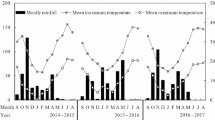Abstract
Sorghum grain yields under the karité and the néré are reduced by an average of 50% and 70% respectively, in comparison with yields in the open field. Soil fertility, limiting primary production in the region, is at least as favorable under the tree canopies as in the open field. Reduced light intensity, to a minimum of 20% under the néré canopy, is probably largely responsible for low sorghum production under the tree canopies. Benefits from the tree products are more valuable than losses in cereal yields, explaining why trees are maintained on the agricultural fields.
Pruning of tree branches, selection of (shade-) crops and tree selection could reduce crop yield losses but cannot be expected to increase tree- and crop production.
Résumé
Les rendements en graines de sorgho sous le karité et le néré sont respectivement environ 50% et 70% plus basses que celles hors des houppiers. La fertilité du sol, étant le facteur limitant pour la production primaire dans la région, est au moins assez favorable sous les arbres que hors des houppiers. L'ombre sous les arbres, réduisant la lumière sous le néré à 20% au minimum, est probablement largement responsable pour la réduction des rendements sous les arbres. Les profits par la vente des produits des arbres sont plus élevés que les pertes de rendements céréaliers, ce qui explique pourqoui les arbres sont conservés dans les champs.
La taille des branches, la selection des cultures qui résistent l'ombre et la selection des arbres peuvent réduire les pertes de rendements, mais n'auront pas un grand effet sur la productivité des arbres ni des cultures.
Similar content being viewed by others
References
Belsky AJ, Amundson RG, Duxbury JM, Riha SJ, Ali AR and Mwanga SM (1989) The effects of trees on their physical, chemical, and biological environments in a semi-arid-savanna in Kenya. Journal of Applied Ecology 26: 1005–1024
Bernhard-Reversat F (1982) Biogeochemical cycle of nitrogen in a semi-arid savanna. Oikos 38: 321–332
Björkman O (1981) Responses to different quantum flux densities. In: Lange OL, Nobel PS, Osmone CB and Ziegler H, eds, Encyclopedia of Plant Physiology. New series volume 12A. Springer-Verlag, Berlin, Heidelberg, New York, pp 57–101
Bounkoungou EC (1987a) Monographie du karité (Butyrospermum paradoxum), espèce agroforestière à usages multiples. Institut de la Recherche en Biologie et Ecologie Tropicale, Ouagadougou, Burkina Faso, 69 pp
Bounkoungou EC (1987b) Monographie du néré (Parkia biglobosa), espèce agroforestière à usage multiple. Institut de la Recherche en Biologie et Ecologie Tropicale, Ouagadougou, Burkina Faso, 56 pp
BUNASOL (1989) Liste des études pédologiques réalisées au Burkina Faso depuis 1955. Document Technique 4, Bureau National des Sols, Ouagadougou, Burkina Faso
CTFT (1988) Faidherbia albida Del. Monographie. Centre Technique Forestier Tropical. Nogent sur Marne, France, 72 pp
Dommergues YR (1987) The role of biological nitrogen fixation in agroforestry. In: Steppler HA and Nair PKR, eds, Agroforestry, a decade of development, pp. 245–271. ICRAF, Nairobi
Guinko S (1985) La végétation de la Haute Volta Tome I. Thèse Doc-Etat des Sciences Naturelles, Université de Bordeaux III, 394 pp
Huxley PA (1985) The tree/crop interface — or simplifying the biological/environmental study of mixed cropping agroforestry systems. Agroforestry Systems 3(3): 251–266
Kapp GB (1987) Agroforstliche Landnutzung in der Sahel-Soudan Zone. Verlag, München, W. Germany, 397 pp
Kessler JJ and Boni J (1991) L'agroforesterie au Burkina Faso. Bilan et analyse. Resource Management Papers 1. Université Agronomique Wageningen, les Pays Bas, 124 pp
Kessler JJ and Breman H (1991) The potential of agroforestry to increase primary production in the Sahelian and Sudanian zones of West-Africa. Agroforestry Systems 13(1): 41–62
Keulen H van and Breman H (1990) Agricultural development in the West African Sahelian region: a cure against land hunger? Agriculture, ecosystems and environment 32: 177–197
Leenaars J (1990) Regeneration of the Nitrogen Availability of Fallow Lands of Oula — Burkina Faso. Department of Nature Conservation, Agricultural University Wageningen, 55 pp
Maïga A (1987) L'arbre dans les systèmes agroforestiers traditionnels dans la province de Bazéga. CNRST/IRBET, Ouagadougou, Burkina Faso, 86 pp
Maydell, H von (1987) Agroforestry in the dry zones of Africa: past, present and future. In: Steppler HA and Nair PKR, eds, Agroforestry, a Decade of Development, pp 89–116. ICRAF, Nairobi
Peltier R and Eyog-Matig O (1988) Les essais d'agroforesterie au Nord-Cameroun. Revue Bois et Forêts Tropiques 217: 3–31
Penning de Vries FWT et Djiteye MA (Eds) (1982) La productivité des pâturages sahéliens. Une étude des sols, des végetations et de l'exploitation de cette ressource naturelle. Agri Res Rep 918. PUDOC, Wageningen, 525 pp
Pichot J (1975) Rôle de la matière organique dans la fertilité du sol. Agron Trop 30: 170–175
Pullan RA (1974) Farmed parkland in West Africa. Savanna 3(2): 119–151
Raison J-P (1988) Les parcs en Afrique: état des connaissances et perspectives de recherches. Encyclopedie des techniques agricoles en Afrique Tropicale, 79 pp
Ruthenberg H (1980) Farming Systems in the Tropics. Clarendon Press, Oxford, 424 pp
Ruyssen B (1957) Le karité au Soudan. L'agronomie Tropicale XII(2): 143–172
Weber F and Hoskins M (1983) Agroforestry in the Sahel. CILSS/USAID, NY, USA, 102 pp
Weltzin JF and Coughenor MB (1990) Savanna tree influence on understory vegetation and soil nutrients in north-western Kenya. Journal of Vegetation Science 1: 325–334
Zongo JD (1977) L'amélioration génétique du sorgho grain. Mémoire de fin d'études DAA. Ouagadougou, Burkina Faso, 55 pp
Young A (1989) Agroforestry for soil conservation. Science and practice of agroforestry 4. CAB/ICRAF, Nairobi, Kenya, 276 pp
Author information
Authors and Affiliations
Rights and permissions
About this article
Cite this article
Kessler, J.J. The influence of karité (Vitellaria paradoxa) and néré (Parkia biglobosa) trees on sorghum production in Burkina Faso. Agroforest Syst 17, 97–118 (1992). https://doi.org/10.1007/BF00053116
Issue Date:
DOI: https://doi.org/10.1007/BF00053116




